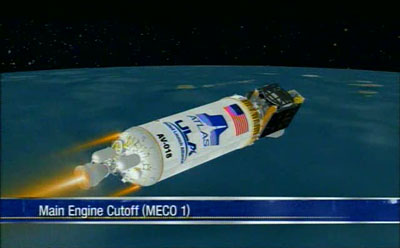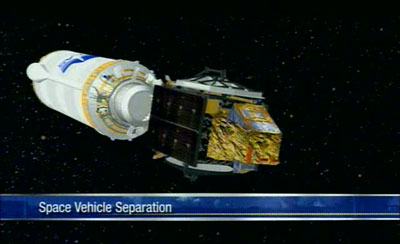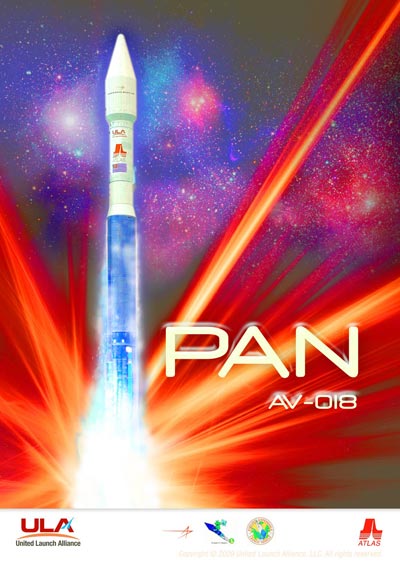PANdora’s Boxby Dwayne Day
|
| What makes it so unusual is that no government agency claims ownership of the satellite. This is unprecedented—even the secretive National Reconnaissance Office acknowledges the satellites that it owns. |
The satellite—or at least the launch—was named PAN. A few weeks before the launch the official launch patch was placed for sale on eBay and it revealed that PAN stood for “Palladium At Night,” a phrase that is equally confusing. (See: “PAN’s Labyrinth”, The Space Review, August 24, 2009.) Also shortly before the launch Lockheed Martin admitted that it had built the satellite and it was based upon a commercial comsat, the A2100. During the launch, the United Launch Alliance showed a web feed that included an animation of a satellite riding atop the Atlas upper stage. It is unknown if this satellite depicts a generic A2100 satellite, or if this is what the PAN satellite actually looks like in its stowed configuration. United Launch Alliance also released artwork associated with the launch that referred to PAN as “the simplest of programs.”
Before the launch, a group of satellite watchers were speculating about PAN’s identity. Canadian Ted Molczan discovered that Lockheed Martin initiated a satellite project named Program 360 in October 2006 after finding a government customer. Lockheed Martin referred to P360 as part of its “Special Programs line of business” and stated: “One such program, P360, successfully marketed and contributed to the start of a major government program. The team’s innovative turnkey commercial based satellite, ground and launch system solution established the foundation for a new government architecture.”
 Video capture of what might be the PAN comsat from the ULA video feed during launch. (credit: United Launch Alliance via www.nasaspaceflight.com) |
Lockheed Martin later stated: “We have successfully hit every milestone on a 30-month firm-fixed-price program that will change the future of how government programs will be contracted and run. This opportunity is a great challenge to build a government satellite that uses the A2100 spacecraft bus and commercial off-the-shelf components and processes. There are numerous future Lockheed Martin opportunities that hinge on the success of this program.”
Molczan also remembered that in 2008, the US Navy’s leadership was becoming concerned that their UFO communications satellite constellation was degrading rapidly, and the replacement Multi-User Objective System (MUOS) satellites would not be ready in time. This would result in a critical gap of capabilities. The Navy announced that it was seeking to put a UFO transponder on a commercial satellite to cover the gap, but canceled its plans in 2009.
| Why do all the announcements about PAN refer to a “government” customer instead of a “Department of Defense” customer? |
When PAN was launched, Greg Roberts was waiting for it with his radio detection equipment in Cape Town, South Africa. He detected a signal consistent with the UFO comsats. Although this is not definitive proof, it initially implies that, just as the amateur observers suspected, PAN is somehow connected to the UFO program.
When trying to determine what a classified satellite is, it is important to separate what is known from what is speculated. Here is what is known about PAN: it is a comsat, it is a quick-turnaround procurement for the government, it is apparently essentially commercially-based technology, it may represent the first of a series of such satellites, and it is apparently connected to the UFO program in some way.
So why is the owner classified? Why doesn’t the Navy simply claim ownership? Why do all the announcements about PAN refer to a “government” customer instead of a “Department of Defense” customer?
Molczan has suggested that the owner might be the CIA. The satellite could be used for communicating with intelligence agents. Veteran satellite watcher Jonathan McDowell has suggested that maybe this is a new generation of National Reconnaissance Office Satellite Data System (SDS) satellites and is being procured under new, tighter security rules.
 Video capture of what might be the PAN comsat from the ULA video feed during launch. (credit: United Launch Alliance via www.nasaspaceflight.com) |
An alternate explanation is that the owner is a government agency that we have not heard about. Several years ago, one of a seemingly endless number of high-level commissions reviewed the operations of the National Reconnaissance Office and suggested that in order to regain some of its procurement and management skills, the NRO should create a super-secret core organization. Perhaps that organization owns PAN. Alternatively, the owner could be a classified anti-terrorist or nuclear monitoring agency. Or perhaps the owner is an organization that remains murky, like the Secret Service, or the Naval Undersea Reconnaissance Office (NURO), which coordinates intelligence collection by submarines.
An alternative explanation is that the mission itself is so classified that its owner is being obscured. It is hard to determine what this would be, but possibilities include stealthy reconnaissance drones operating in foreign airspace (like over Iran), or emplaced sensors used to monitor things like radiation and other nuclear weapons signatures.
| What is fact is that PAN remains a very mysterious bird. |
The agent communications explanation is probably the least likely of those suggested. There are now so many ways for a person on the ground to communicate, and individuals require relatively low bandwidth, that it seems unlikely the CIA would buy a dedicated satellite for this purpose. During the 1960s the CIA reportedly developed several satellites for this reason, with names like TENNIS and TALCUM. These were probably variants of the low-altitude signals intelligence satellites then in operation and they were probably used in a store-dump mode, with somebody on the ground sending signals up to the satellite where they were recorded and then played back when the satellite reached friendly territory. However, the communications set was so big that nobody could carry it around and set it up without risking discovery. It seems likely that an easier method to relay information would be to send a low-power signal up to an American signals intelligence satellite, which would be listening for signals coming from a specific area anyway. Today, there are infinitely more options, including simply giving an agent an Iridium satellite phone, or using a standard cellphone with some kind of encryption.
More likely is some other kind of classified communications, such as controlling the CIA’s fleet of unmanned aerial vehicles (UAVs). UAVs can be bandwidth-intensive, and the CIA has been reported to be operating them over Yemen, Iraq, Iran, Afghanistan, and Pakistan. As the Air Force reluctantly increased the number of UAVs in its own fleet, maybe it became harder for the CIA to negotiate for bandwidth on Air Force or Navy satellites to control its UAVs. Maybe Lockheed Martin came along with a proposal to use a commercially-based comsat at just the right moment. All of this is speculation, not fact. What is fact is that PAN remains a very mysterious bird.
